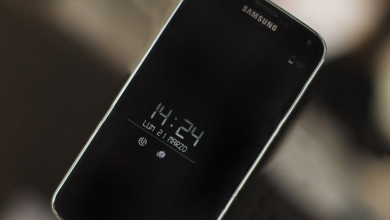Fix: Always on Display not Working on Samsung Galaxy
Always on Display (AOD) may not work for Samsung Galaxy phones due to an outdated version of your phone’s OS. Moreover, the wrong configuration of your phone (like Lift to Wake, Power Saving mode, Screen Saver, etc.) may also result in the error under discussion.
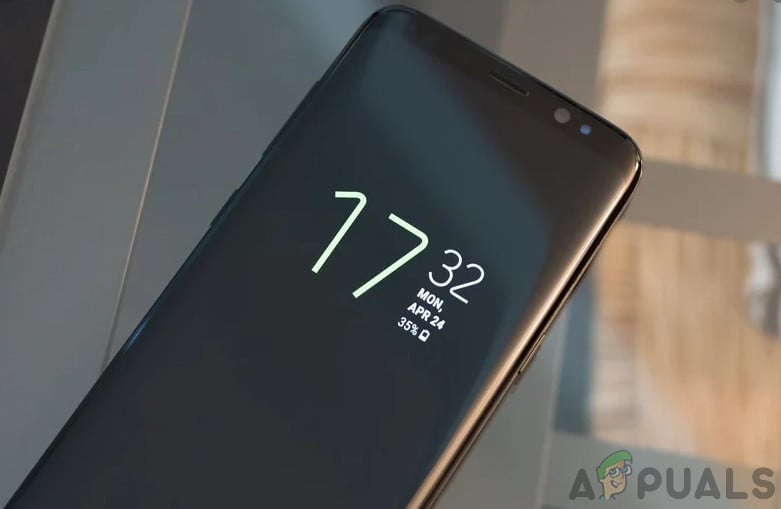
The affected user mainly encounters the error after an OS or AOD application update. In some rare cases, the issue is reported on new phones. For some users, the AOD works for a few seconds and then fades away. In some instances, the issue is reported to occur with only Clearview Cover.
Before moving on with the solutions to solve the Always-on Display problem, restart your phone and check if the issue was due to a temporary glitch. Moreover, check if the Do Not Disturb mode of your phone is not enabled. Additionally, make sure AOD is enabled in the phone’s settings. Make sure the Display Mode of AOD is set to Show Always (Settings>Lock Screen> Always on Display>Display Mode) and if the Display Mode is set to the scheduled mode, then edit the schedule to meet your requirements.
Also, try to enable the Smart Lock option (Settings> Lock screen and Security>Secure Lock Settings>Smart Lock) and then check if AOD is working fine. Attempt to change the clock style of AOD as, in some cases, the clock style changed to the black screen after an update (Settings>Lock Screen> Clock Style > Always on Display).
Solution 1: Disable the Power Saving Mode of Your Phone
Power Saving mode is quite essential in enhancing the battery timing of your phone. You may encounter the issue at hand if the power saving mode of your phone is enabled as this feature limits the operation of many processes (including AOD) of your phone. In this case, disabling the power saving mode may solve the problem.
- Slide down from the top of the screen to expand the notifications tray.
- Now tap on “Turn Off Battery Saver” (located under the “Battery saver is on”) and then check if AOD is operating fine.
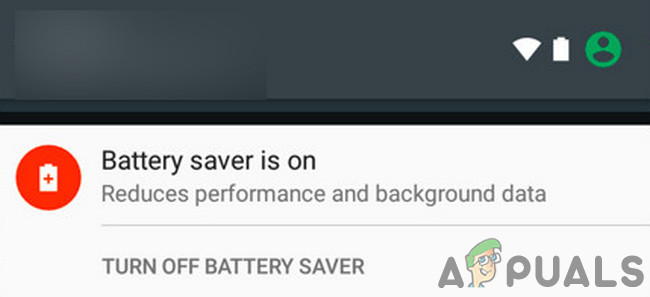
Turn Off Battery Saver
Solution 2: Disable the Screen Saver of Your Phone
The Screen Saver of your phone plays a vital role in saving the screen of your phone from the pixel burn. However, the screen saver can override AOD and display itself instead. In this scenario, disabling the screen saver of your phone may solve the problem.
- Launch the Settings of your phone and then tap on the Display option.

Open Display in Your Phone’s Settings - Scroll down to the bottom of the menu and then open the Screen Saver option.
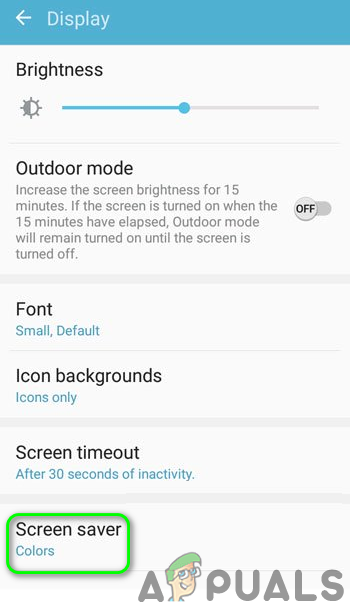
Tap on Screen Saver in the Display Settings - Then disable the Screen Saver by toggling its switch to the off position.

Disable the Screen Saver of Your Phone - Now restart your phone and upon restart, check if AOD is working fine.
Solution 3: Disable Lift to Wake Feature of Your Phone
Samsung phones have a feature ‘Lift to Wake’ and when the said feature is enabled, the phone’s display will turn on when the user picks up the phone to use. However, this module is known to glitch with Always on Display. In this context, disabling the Lift to Wake feature may solve the problem.
- Launch the Settings of your phone and then tap on the Advanced Features.
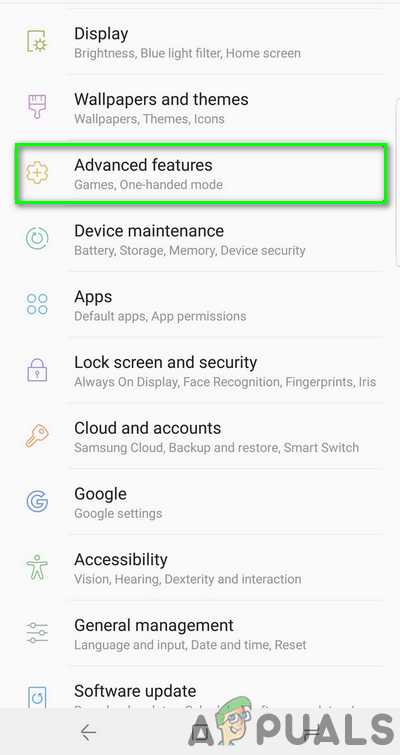
Open Advanced Features of Samsung Galaxy - Now tap on Motion and Gestures and then disable the Lift to Wake feature by toggling its switch to the off position.

Disable Left To Wake - Now restart your phone and upon restart, check if Always-on Display (AOD) is clear of the error.
Solution 4: Disable Roaming Clock in the Phone’s Settings
The roaming clock is a handy feature that helps a user to use a dual clock on his screen. But this feature interrupts the operation of Always-on Display (AOD) and thus may prevent it from displaying. In this context, disabling the Roaming clock may solve the problem.
- Launch Settings of your phone and tap on Lock Screen & Security.
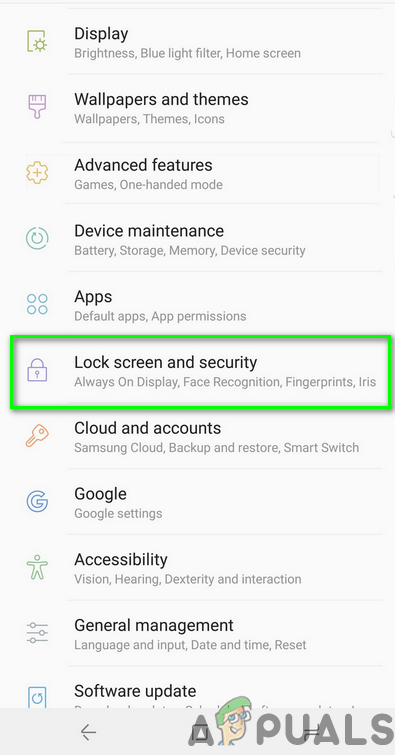
Open Lock Screen & Security in the Settings of Your Phone - Then open Clock and FaceWidgets and disable Roaming Clock.

Disable Roaming Clock - Now restart your phone and upon restart, check if AOD is clear of the error.
Solution 5: Update the Bixby Routines to the Latest Build
Bixby Routine is one of those applications which can be used to manage the AOD settings of your phone. Always on Display may fail to get displayed if the Bixby Routines application is outdated. In this context, updating the Bixby Routines may solve the problem. Keep in mind that Galaxy S10, S20, Note10, Z Flip, and Fold series Samsung phones have this option available.
- Swipe down (with two fingers) from the top of the screen to open the Quick settings menu.
- Now swipe left and then tap & hold the icon of Bixby Routines.
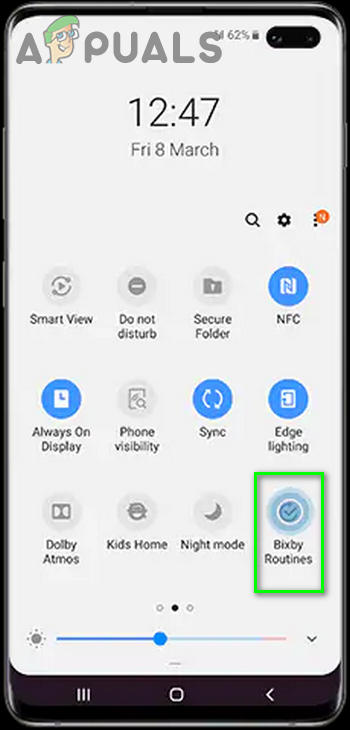
Tap and Hold Bixby Routines - Now tap on Vertical Ellipsis (3 vertical dots) and then tap on Settings.
- Then open About Bixby Routines
- Now check if an update of the application is available, if so, then update the Bixby Routines.
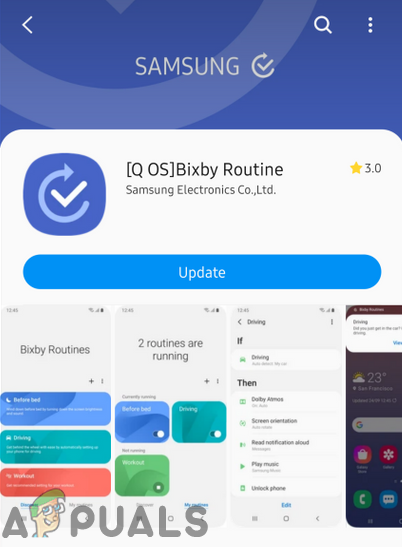
Update Bixby Routines - After updating Bixby Routines, restart your phone and upon restart, check if AOD is working fine.
Solution 6: Clear the Storage Data of Always on Display
AOD may also fail to display on your screen if the storage data of the Always-on Display is corrupt. In this context, clearing the data may solve the issue instantly.
- Launch the Settings of your phone and then tap on the option of Applications/ Apps.
- Now tap on the 3 vertical ellipses (3 vertical dots near the top left or bottom of the screen) and then tap on Show System Apps.
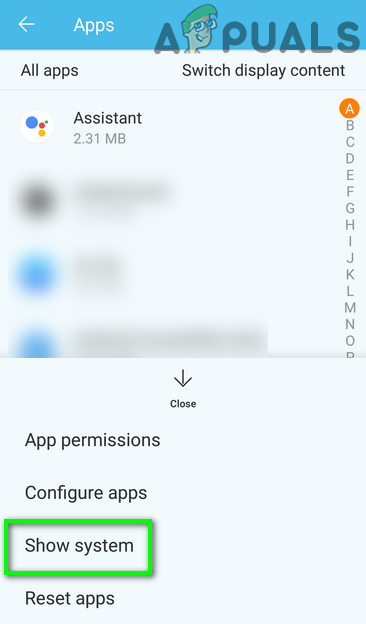
Show System in Apps Settings - Then open Always on Display and tap on Force Stop.
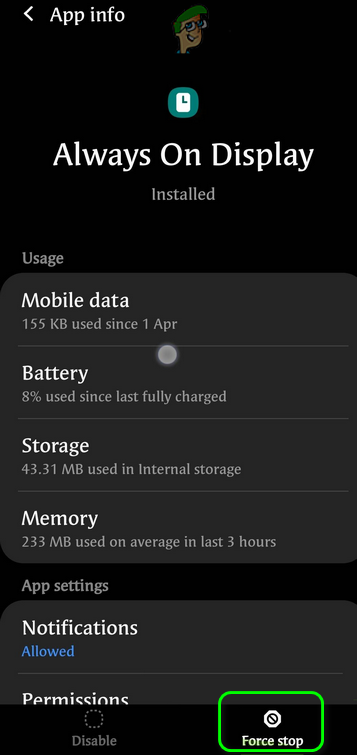
Force Stop Always on Display - Now tap on Storage and then tap on Clear Cache.

Tab on Storage in Always on Display Settings - Now tap on the Clear Data button and then confirm to delete the data (you may have to reconfigure the AOD).
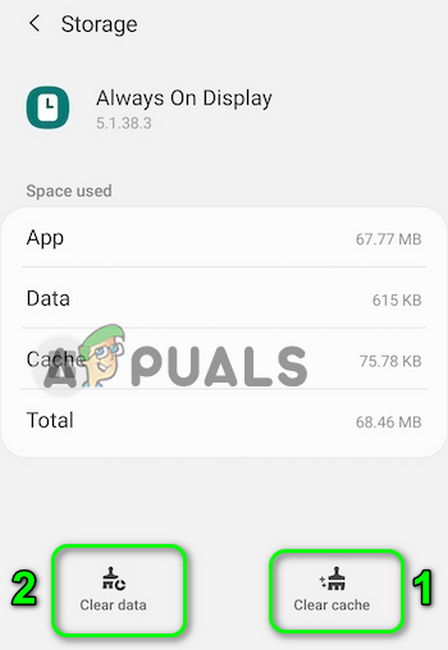
Clear Cache and Data of Always on Display - Then restart your phone and upon restart, check if AOD is working fine.
Solution 7: Uninstall the Google Play Store Version of ‘Always on Display’
Always on Display (AOD) is available in two forms, one as a Samsung phone setting and the other as an application from the Google Play Store. You may encounter the error under discussion if you are trying to configure AOD through the Play Store application.
In this context, uninstalling the Google Play Store application and configuring the AOD through your phone’s settings may solve the problem.
- Launch the Settings of your phone and then tap on the option of Application Manager/Apps.
- Now find and tap on Always-on Display.

Open Always on Display in the Application Manager - Then tap on the Uninstall button to uninstall the Always-on Display.
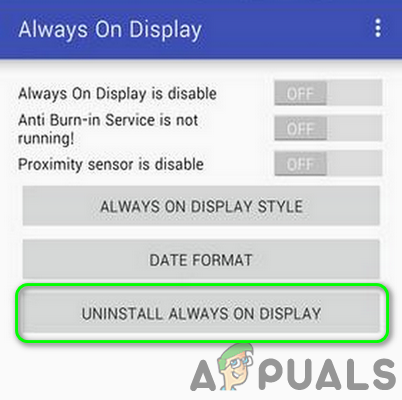
Uninstall Always on Display - Now restart your phone and upon restart, launch the Settings of your phone.
- Now open the settings of Lock Screen and then tap on Always-on Display.
- Then enable the Always-on Display and check if the issue is resolved.
- If not, open the Galaxy Apps and check if there is an update of AOD is available. If so, then update AOD and check if AOD is working fine.
Solution 8: Uninstall the Updates of Always on Display
AOD is regularly updated to patch known bugs and cater to new features or faces for the application. However, buggy updates are a common issue in the application development process and the error at hand could also be a result of a buggy update. In this context, removing the updates of AOD may solve the problem.
- Launch the Settings of your phone and then open the option of Applications/ Apps.
- Now tap on the 3 vertical ellipses and then tap on Show System Apps.

Show System in Apps Settings - Then open Always on Display and tap on 3 vertical ellipses (near the top right or bottom of your screen).
- Now tap on Uninstall Updates and then restart your system.
- Now check if AOD is working fine. If not, open the Galaxy Apps and check if an update of AOD is available. If so, then update AOD and check if the issue is resolved.
Solution 9: Reset the Always-on Display to Factory Defaults
If the very installation of the application is corrupt or has bad configurations, it will fail to operate properly. In this context, resetting the AOD to the factory defaults may solve the problem.
- Launch the Settings of your phone and open the Lock Screen option.
- Now tap on Always on Display and then tap on the “i” icon (near the top right corner of the screen).

Open Always on Display in the Lock Screen Settings - Then tap on Version (at the bottom of the screen) and then tap Reset to Factory.
- Now restart your phone and upon restart, check if AOD is working fine.
Solution 10: Update the OS of Your Phone to the Latest Build
The OS of your phone is continuously updated to patch the known bugs and provide compatibility to all newer applications. You may encounter the error at hand if the OS of your phone is not updated to the latest build which may cause issues in the application running. In this context, updating the OS of your phone to the latest build may solve the problem.
- Create a backup of your phone and connect your phone to a WIFI network. Then put your phone on charging and wait till your phone is 100% charged.
- Launch the Settings of your phone and then tap on About Phone.
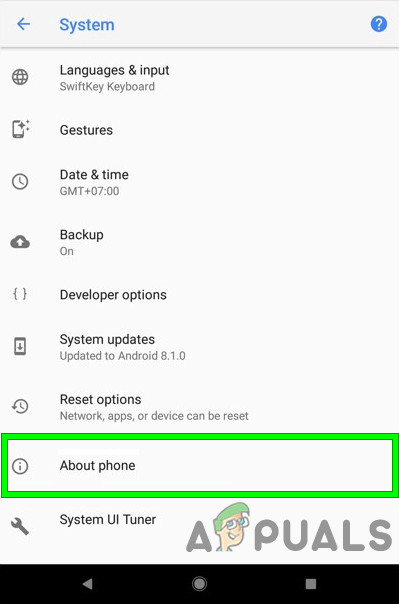
About Phone - Now tap on Check for Updates and if the Update button shows up, tap on the Update button.
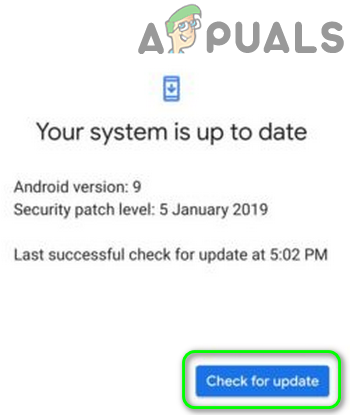
Check for Updates - Once the update is complete, restart your phone.
- Upon restart, check if Always On Display (AOD) is working fine.
Solution 11: Uninstall the Conflicting Applications
We came across several cases where third-party applications were conflicting with the AoD function of the Samsung watch. Here, you have to troubleshoot yourself and diagnose which one would be causing the problem. You can start with the most recently installed ones.
- Launch the Settings of your phone and then open the option of Application Manager/Apps.
- Now try to find any of the problematic applications. Holey Light, Notification Light/LED AOD Notify, Bixbi Button Remapper, Good Lock, AODNOTIFY Pro, etc. are known to create issues (if not configured properly) for AOD.
- Now tap on the problematic application and then tap on the Uninstall button.
- Repeat the process for all of the problematic applications and then restart your phone.
- Upon restart, check if AOD is operating fine.
Solution 12: Reset the Device to the Factory Defaults
If nothing has worked for you so far, then, most probably the AOD issue is a result of a corrupt OS of your phone. In this context, resetting your phone to the factory defaults may solve the problem. Keep in mind that everything will be erased so keep a backup of everything essential for you. Also, decrypt your SD card (if encrypted).
- Back up your phone (you can also use the Smart Switch application) and make sure your phone is charged to 100%.
- Launch the Settings of your phone and then tap on Backup and Reset.
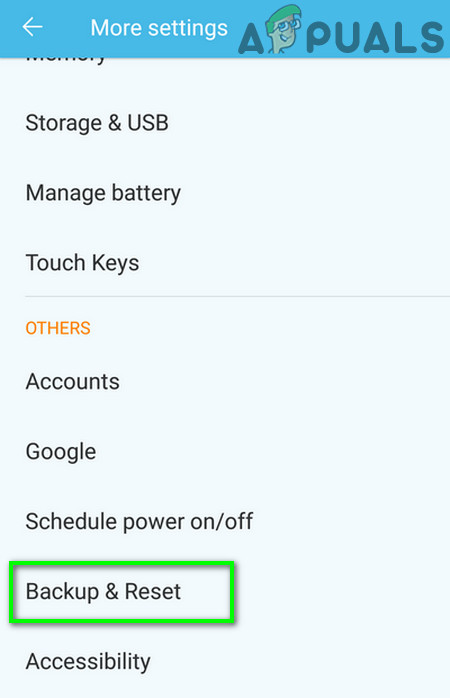
Tap on Backup and Reset - Now tap on Factory Data Reset and then tap on Reset Device.
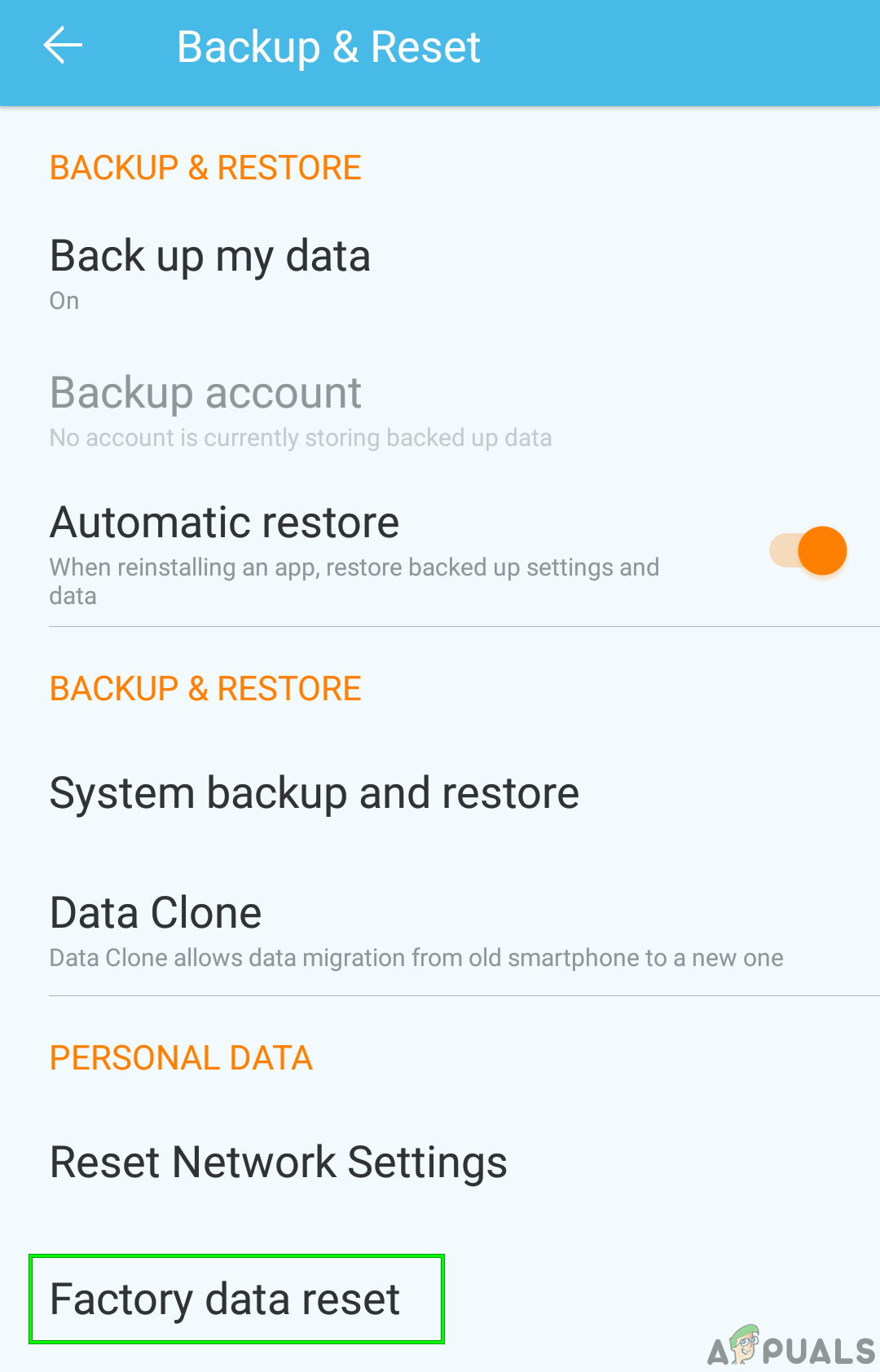
Factory Data Reset - Now confirm to Reset the device by tapping on the Delete All button.
- Then wait for the completion of the reset process of your phone and hopefully, the Always-on Display (AOD) issue is resolved.
If nothing has worked for you, then try to use an application to manage AOD settings of your phone like Good Lock, AODNOTIFY, etc.




